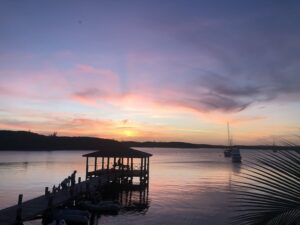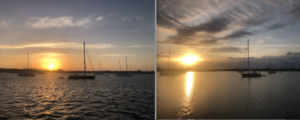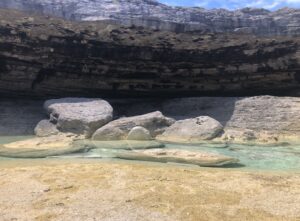Elusive Eleuthera
Getting to Eleuthera proved to be a delight and even though the second evening in the area turned out to be exasperating (and exhausting), it’s still a very lovely place. Unfortunately, as mentioned before, there was inclement weather bearing down on the region and really only one truly secure location, and we had to get to Spanish Wells so my crew could catch a plane back to the modern world. So with that in mind, after (finally) making a successful reprovisioning run to the grocery store in Rock Sound, we hot-footed it northwest across the Bight of Eleuthera to Hatchet Bay.
Which turned out to be both a really good decision and kind-of an unfortunate decision. It was a good decision because we got to the bay well ahead of all the other boats in the area that were headed to Hatchet Bay to ride out the storm, so we staked out an anchorage and were good to go. But it was also unfortunate because while the wind DID blow pretty heavily, it wasn’t really THAT bad and we likely could have found safe anchorages elsewhere that would have allowed us to explore more of the island. For that reason, Eleuthera remains a bit of an unknown for me. Case in point: We went nowhere near Governor’s Harbour in the middle of the island. And our Austrian friends who’ve been traveling the same paths said Pelican Bay was truly beautiful. I saw neither of those, nor some other places I’d like to have checked out. As such, I would like to return to explore more someday.

Yet another stunning sunset…this one at Boater’s Haven, aka Emmett’s, on the shore of Hatchet Bay in Alice Town
As for Hatchet Bay: The bay bills itself as “the island’s safest anchorage” and it is most assuredly that. It’s guarded by the wall of solid rock that makes up the coastline in that area and has only one entrance that surely must have been carved and gouged (dynamited) by man in years past. It’s not much wider than a modern catamaran and when the south wind during the storm was pushing decent-sized waves at the coast and the gap, the inlet looked like a washing machine: waves bounced from side to side, criss-crossing into a maelstrom that would not be fun to traverse. But inside during the storm, the bay was pretty chill. Yeah, there was a little chop from the strongest winds but nothing major.
Anyway, when Further arrived at Hatchet Bay there were already about a dozen boats spread around. There was still plenty of room but that didn’t stop me from spending a good half-hour trying to find the ideal anchoring spot. I finally put the anchor down midway between a couple of other similarly sized sailboats, slightly ahead of them both so we weren’t in a line but had our own spaces. However, the owners of one of the boats weren’t on board when we anchored and when they returned sometime after we were set, they raised their anchor and moved straight ahead and a bit forward of us. I figured they were peeved, thinking we’d anchored too close to them. Nope. I talked to them later and they said that while they were gone, their boat had dragged a good three hundred feet. A harbinger of boats dragging in soft bottom? Gulp…
When we got our anchor down, I grabbed my mask and snorkel and dove to check out the situation. I found a nasty, manky bottom, with tons of Cassiopeia-style jelly fish and enough silt that I couldn’t see the anchor on the bottom. I had to grab the anchor chain where it emerged from the muck and pull myself down to the end, where I found the anchor quite well buried (and indeed, in one anchoring attempt prior to this one that I stayed with, when the anchor came up it was covered in sand and shells and roots; it got down into the surface). Content that we were well secured, I returned to Further and immediately noticed that not only did the water look nasty, on my skin it kinda smelled nasty, too. Yeah, I mean: nasty. Thankfully, the solar shower was full and sitting on deck in the sun, so I cleaned off the stink and vowed not to get into the water again.
A couple of boats arrived, pronounced the bay too crowded and left. Other boats arrived and stayed. And we all settled in for the impending blow. Fortunately, in the southeastern corner of Hatchet Bay, in the village of Alice Town, there is a great little bar/convenience store/kind-of restaurant with a great dinghy dock, where many of us gathered each evening for a couple of beers, a bite to eat and yet more awesome Bahamian sunsets. The proprietor, a legendary guy named Emmett, was suffering from asthma so we missed out on his much-heralded singing and guitar playing. He played us a couple of his recordings, but it wasn’t quite the same. They also had a cat there that had the most amazing eyes—they looked like the almond-shaped eyes you see in drawings of extraterrestrials. Eerie…but very cool.
I awoke around 5 a.m. that first night and went topside, where I found that neighboring boat that had dragged twelve hours earlier once again out of position and back by the shore. The owners were wrangling the boat back into position, this time a little farther away (whew!), and this time the anchor held. Further’s Rocna anchor never budged. Booyah! Later that day, after the sun rose fully, my crew took my bicycle and wandered the island; I stayed on board to make sure our anchor held…and that one one else dragged into us. I needn’t have worried but, well, I did. It’s what I do. Yes, I’m trying to live in faith and not in fear, but I’m also trying to be a wise, safe mariner. So I hung close to home.

There’s a bar on the hill above the anchorage at The Glass Window. Guess who that is anchored out there…
But on the night before departing, I walked over to a well-touted restaurant at the other end of Alice Town from Emmett’s. It’s called Twin Brothers and it turned out to be wonderful. Like many restaurants in the islands, it was outdoors. I grabbed a seat at the bar, joining an older local woman and a family of four, all of whom were watching a best-of reel of “Family Feud” contests. I settled in, joined in the guessing game with the others, and enjoyed a delightful lobster fettuccine. It was a good way to end my time in Alice Town/Hatchet Bay.
Would I return? Certainly. I’d love to explore some of the neighboring areas—there are caves nearby, there’s supposed to be a new national park right next to the bay that is a haven for seahorses (it was closed and virtually everyone I’ve ever spoken to about the place said you never see any seahorses), and for cryin’ out loud, the neighborhood of Surfer’s Beach is just a few miles up the road on the Atlantic Ocean side of the island. I’d just be sure to stay out of the water in Hatchet Bay itself (though we did see sea turtles in there, and some cruisers at Emmett’s said they’d seen an adult and young manatee as well).
We did explore a bit upon leaving Hatchet Bay. About an hour to the northwest up the island is an area known as The Glass Window. The Glass Window itself is a bridge on the only road that runs the length of the island. During a storm several years ago, the waves and surge were so great that the bridge actually moved a bunch; it’s still in place but it’s single-file now and supposedly there are plans to rebuild it. But it’s still cool to walk out onto the bridge and check out the fiery Atlantic on one side and the calm Bight of Eleuthera on the other.
And nearby, the Queen’s Bath is a really cool set of pools carved out by the ocean on a little shelf just above sea level. The Atlantic surges in and fills the pools, which are then warmed by the sun and are a really nice place to hang out and enjoy the majesty of the ocean. It truly inspires awe to see the ocean water charge into the gaps in the land, explode into the air and then race back out to join the next wave’s assault on the rocky rampart. Definitely worth the visit.
The next obstacle on the journey was a gap between islands that links the Bight of Eleuthera with the banks in the Spanish Wells area. Known as Current Cut, the gap is where a massive volume of water constantly moves in and out with the tide—constantly, that is, except at slack tide, which basically occurs around the times of high and low tide. But as with other bodies of water that also move a lot, it behooves mariners to not transit such areas when the wind is going against the current, otherwise you’ll be dealing with steep, choppy waves that damage boats and people.
With that in mind, after a night at The Glass Window, we moved about ten miles to the southwest and anchored in Little Bay, just south of Current Cut. It turned out to be a nice, quiet anchorage that was home to a couple of packs of dogs that roamed the beaches of the bay. They weren’t wild; the dogs are owned and fed by a guy who lives on the island. But they also pretty much just roam so they race up and down the beach trying to get boaters’ attention, and they bark. A lot. It was actually kinda cool, and my crew took a SUP to shore to meet the owner and the dogs. I snorkeled (not a lot to see) and did chores on the boat. But it turned out to be a really nice anchorage, with unbelievable stargazing thanks to there being no lights anywhere nearby.
And in the morning, just after high tide, Further passed through Current Cut with almost no moving water whatsoever. Uneventful, to say the least.
We anchored that day on the southwest side of a spot called Meeks Patch and took the SUPs out to explore. There are a couple of islands there, with nice beaches on which the locals have put picnic tables, a grill and other structures for their weekend fun. The main island at Meeks is yet another pig beach, with swimming pigs that live on the island and swim for the tourists who come to visit. There were also chickens and ducks (and sea slugs!) at the pig beach, where I chatted with a couple of young local guys who were there to take care of the animals—and the tourists who come to visit…which they did, so we took the SUPs and departed whence we came. But in the time we’d been chatting the tide had dropped enough that it was too shallow to paddle, so we were forced to walk the SUPs across the flats behind the island seeking deep-enough water.
Bad move. While we were walking, I kept thinking to myself, “You should go up to the beach. This is where stingrays live.” And sure enough, BAM! I felt a sharp pain in my left foot and knew immediately what had happened. I got a few feet farther along where the water deepened and sat on my SUP. There was a tiny trickle of blood from the minuscule incision the little bugger (who I never did see) had made with his tail, and the area was already beginning to swell. I told my crew what had happened and then paddled over to the beach where some locals were picnicking. I showed them the wound, asked them if I should be worried and they told me two things: one, that it didn’t look like a stingray wound; and two, there was no need to worry.
Well, I knew damned well it was a stingray wound—there’s nothing else in those waters that would cut like that. And I knew that my foot was hurting. So I paddled back to the boat, secured the SUP and got online. I did the one bit of advice that seemed to make sense: I soaked the wound in hot water, and then I put some Bacitracin and a Band-Aid on it. For the next couple of hours, the pain came and went in waves that got fewer and farther between, and by dinnertime it just sorta ached. By the time I woke up the next day, it was just another cut on my body that hurt and would take time to heal. Moving on. But hey, now I’ve been stung by a stingray…that was a first.
Since my crew was heading to the nearby North Eleuthera airport the following morning, we wanted to spend the night anchored closer to Spanish Wells itself, where there was ferry/taxi service to the airport. We proceeded into the narrow channel into town, behind another sailboat (who turned left to go up channel and promptly ran aground) and ahead of a catamaran (who was barreling up Further’s butt for some reason). As we turned to the east, we saw a big barge—the kind that serves the islands of the Bahamas by delivering supplies—sticking almost entirely across the channel. Oh boy…what now?

‘Twas a deft bit of maneuvering, if I do say so myself, that got Further past this barge in Spanish Wells Harbour
Well, I squeezed Further through a narrow gap at the barge’s stern, a gap that was far too small for the catamaran to follow so he turned around and went who-knows-where. And on the other side of that gap we pulled up to five mooring balls just beside the channel. One other boat was already in place on one mooring, so we took the ball farthest away—a good thing, because the mooring balls were way too close together; there’s no way they could all be occupied at the same time—and settled into Spanish Wells.






